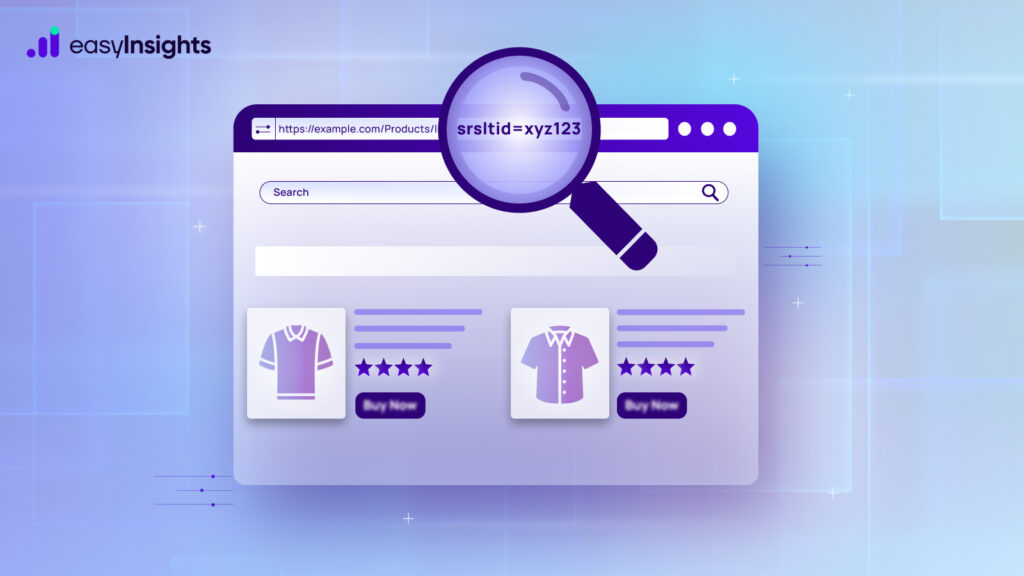
Ever noticed strange strings of letters and numbers like ?srslttid=xyz123 appearing at the end of your website URLs? If so, you’re not alone. Many site owners see these SRSLTID parameters and wonder if they’re harmless or secretly hurting their SEO performance.
SRSLTID parameters are tracking codes, often added by ad platforms or third-party tools, that monitor the origin of your traffic. While they’re useful for marketing analytics, they can create duplicate URL versions of the same page, which can confuse search engines and dilute your rankings.
If you’ve ever checked your site’s analytics and seen multiple URLs leading to the same content, you might already be experiencing the impact without realising it. This is where proper handling of SRSLTID comes in because when left unchecked, these parameters can lead to crawl inefficiency, duplicate content issues, and wasted SEO potential.
In this blog, we’ll revisit a common but often-overlooked problem in digital marketing: how tracking parameters like SRSLTID affect your website’s SEO. We’ll break down:
- What the SRSLTID parameter is and why it appears in your URLs.
- How it can impact your search rankings and crawl budget.
- Simple, proven ways to fix and prevent SEO damage.
Because once you understand what’s happening behind the scenes, you can clean up your URLs, protect your rankings, and make sure search engines see your site exactly as you want them to.
Jump ahead to:
What is the SRSLTID Parameter and How Does It Work?
If you’ve ever clicked on a product listing or certain search results in Google and noticed a strange extra bit at the end of the URL, something like ?srsltid=abc123, you’ve just met the SRSLTID parameter.
SRSLTID stands for Search Result Source Listing ID, and it’s a tracking code automatically added by Google. Its main job? To help Google understand which listings people click on and how they interact with them. You’ll most often see it when clicking on Google Merchant Centre product listings (like Google Shopping ads), but it can also appear with regular search results. Here’s a simple example:
- You search for “best web hosting” on Google.
- You see a product listing and click on it.
- The original link might have been: https://example.com/Products/linux
- After the click, you see: https://example.com/Products/linux?srsltid=xyz123
That extra srsltid=xyz123 part doesn’t change the content of the page; it just tells Google, “Hey, someone clicked on this listing.” This helps with performance tracking, engagement analysis, and ad optimization. While SRSLTID is harmless for the user experience, it can create SEO issues if not handled properly, such as:
- Duplicate versions of the same page in search results.
- Wasted crawl budget for search engines.
- Diluted SEO ranking signals.
The SRSLTID parameter is useful for analytics but needs to be managed to avoid hurting your website’s SEO performance.
Additional Reading: Removing FBCLID from Google Analytics (GA4) Reports
Does Google Index SRSLTID URLs
The short answer is yes, Google can index URLs with the srsltid parameter. While Google has officially said that this parameter doesn’t directly affect crawling, indexing, or rankings, real-world checks tell a different story.
If you search for inurl:srsltid= on Google, you’ll see millions of pages show up. This means Google sometimes treats these SRSLTID URLs as separate pages from the original clean URL. And that’s where the problem starts. Here’s why it matters for SEO:
- Every time someone clicks on your Google Shopping listing or certain search results, a new SRSLTID parameter is generated.
- Over time, this can create hundreds or even thousands of duplicate URLs for the same page.
- Search engines may waste crawl budget going through these duplicates instead of focusing on your important content.
- Duplicate content can dilute your ranking signals, making it harder for your main page to rank.
For example:
- Original URL: https://www.yoursite.com/product
- Indexed variations:
- https://www.yoursite.com/product?srsltid=abc123
- https://www.yoursite.com/product?srsltid=xyz456
- https://www.yoursite.com/product?srsltid=qwe789
- https://www.yoursite.com/product?srsltid=abc123
Even though all these URLs show the same content, Google might still index them separately, leading to cluttered search results and possible SEO issues.
How Does the SRSLTID Parameter Impact SEO
When the srsltid parameter shows up in your URLs, it can cause a few headaches for your SEO performance. Here’s why:
- Duplicate Content Problems – The srsltid parameter creates multiple URL versions for the same page. Search engines like Google may end up indexing all these versions separately.
- Split Link Equity – Instead of your backlinks and ranking power going to one main page, they get scattered across several duplicates. This dilutes your page’s overall authority.
- Ranking Drops – Google might not always combine ranking signals from all those duplicates, which can make your primary page lose visibility in search results.
- Canonical Tag Conflict – Normally, SEO experts use the rel=canonical tag to tell Google which version of a page is the “main” one. But if Google itself adds srsltid variations, it works against the very purpose of canonicalization, making the problem worse instead of better.
Srsltid URLs can confuse search engines, hurt your rankings, and waste your link-building efforts. Cleaning them up or preventing them from being indexed is key to keeping your SEO health strong.
Additional Reading: Understanding GCLID, WBRAID, and GBRAID: How Google Is Adapting to iOS Privacy Changes
How SRSLTID Affects Google Search Console & GA4 Tracking
The srsltid parameter isn’t just an SEO issue; it can also mess with how your data appears in Google Search Console and Google Analytics 4 (GA4).
- Reporting Confusion in Google Search Console – When srsltid URLs get indexed, they can skew impression and click numbers. This means you might see strange variations of your URLs in reports, making it harder to track which pages are performing well.
- Tracking Gaps in GA4 – GA4 often struggles to track srsltid URLs properly, which can lead to missing or incomplete data in your reports.
- Traffic Misattribution – The biggest problem? Traffic from regular organic search results can be wrongly credited to Google Shopping because of the srsltid tag. This can mislead eCommerce site owners into thinking certain campaigns are doing better (or worse) than they really are.
- Uncontrolled URL Sharing – People often copy a page link from their browser and share it on social media, emails, or messages. If that link contains the srsltid parameter, the “messy” version of the URL spreads across the internet, and you have no way to control it. Over time, this can make your analytics even more inaccurate.
Srsltid URLs can cause reporting errors, traffic misattribution, and messy data tracking, all of which make it harder for brands to make smart, data-driven decisions.
How to Handle SRSLTID URLs
Dealing with srsltid URLs is important if you want clean tracking, accurate SEO data, and better search performance. Here’s what you can do:
- Use Canonical Tags – Add a rel=canonical tag pointing to your main page URL. This tells Google which version should be treated as the original, reducing duplicate content issues.
- Set URL Parameters in Google Search Console – Inside Search Console, you can tell Google how to treat specific URL parameters like srsltid. This helps avoid unnecessary indexing.
- Block via robots.txt (Optional) – If these URLs don’t need to be crawled, you can disallow them in your robots.txt file. But be careful, this can impact existing indexed pages.
- Use Clean URLs in Internal Linking – Make sure your own site’s links never include srsltid parameters. Always link to the clean, main version of the URL.
- Filter in GA4 Reports – In Google Analytics 4, set up filters to strip the srsltid parameter so your reports remain accurate and easier to read.
- Watch Out for External Sharing – If people share srsltid URLs, try to redirect them to the clean version using server-side redirects or by setting preferred URLs.
By managing these URLs properly, you can avoid duplicate content penalties, keep your analytics clean, and ensure your SEO efforts aren’t wasted.
Conclusion
The SRSLTID parameter might seem like just a harmless extra bit in your URLs, but if left unchecked, it can quietly harm your SEO rankings, Google Search Console data, and GA4 tracking accuracy. From creating duplicate content to splitting link equity and misreporting traffic sources, the impact can be greater than most site owners realise.
The good news? With the right SEO practices like using canonical tags, setting URL parameters in Search Console, and cleaning up analytics data, you can stop SRSLTID from wasting your crawl budget or hurting your rankings.
If you want to go one step further, tools like EasyInsights can help you unify and clean your tracking data across all platforms. That means no more messy reports, no more lost traffic attribution, and a much clearer picture of your marketing performance so you can focus on driving results, not fixing reporting errors.
To know more Book a demo Today!








